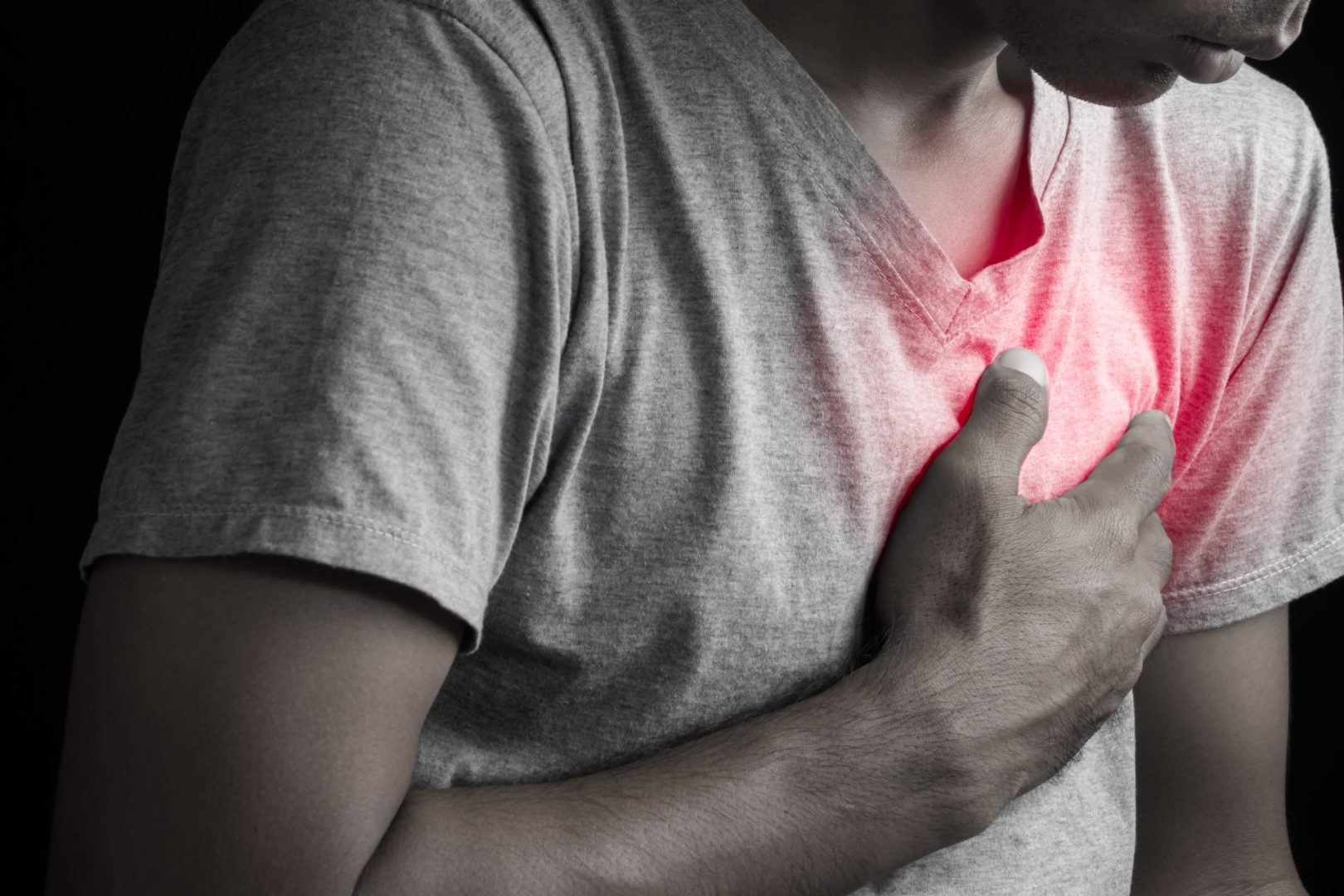When a heart attack progresses to its final, most dangerous phase—cardiac arrest—the line between life and death becomes measured in minutes. Understanding what happens physiologically during this critical period, recognizing the warning signs that precede it, and knowing the immediate actions that can save a life provides essential knowledge for anyone who might witness this emergency. While medical professionals remain the definitive source for treatment, bystander actions in the crucial first minutes often determine whether someone survives until advanced care arrives.
Understanding the progression to cardiac arrest
A heart attack (myocardial infarction) and cardiac arrest represent different but connected events in a potentially fatal cascade. Understanding this progression helps clarify why specific symptoms appear and why certain interventions prove critical during different phases.
Heart attacks begin when blood flow through coronary arteries becomes severely restricted or completely blocked, typically by a blood clot forming at a site where cholesterol plaque has ruptured. This blockage prevents oxygen-rich blood from reaching a portion of heart muscle, causing tissue damage that starts immediately and progresses with each passing minute. Initially, the heart usually continues beating, though abnormally, as portions not receiving adequate blood flow struggle to function properly while still-oxygenated areas attempt to compensate.
During early and intermediate heart attack stages, characteristic symptoms often include chest pressure or pain (frequently described as heaviness, squeezing, or burning), pain radiating to the left arm, shoulder, or jaw, shortness of breath, cold sweats, nausea, and unusual fatigue. These warning signs indicate heart muscle stress and injury but usually mean the heart continues functioning adequately enough to maintain circulation. Approximately 30% of heart attacks present with atypical symptoms, particularly in women, elderly individuals, and those with diabetes, potentially including unusual fatigue, vague discomfort, or symptoms mistaken for indigestion.
The transition to electrical instability marks the critical boundary between a heart attack and potential cardiac arrest. As heart tissue becomes increasingly oxygen-deprived, the heart’s electrical system grows unstable. This electrical system normally coordinates the precise timing of heart chamber contractions that create effective pumping action. When damaged or oxygen-starved, the system may produce chaotic electrical signals that prevent coordinated contractions.
Ventricular fibrillation represents the most common life-threatening heart rhythm during severe heart attacks. In this condition, the heart’s lower chambers (ventricles) quiver ineffectively instead of contracting in a coordinated manner. This chaotic activity prevents blood circulation, quickly leading to unconsciousness as the brain becomes oxygen-deprived. Without intervention, irreversible brain damage begins within 4-6 minutes, with survival chances decreasing approximately 10% with each passing minute without treatment.
Ventricular tachycardia sometimes precedes ventricular fibrillation, creating extremely rapid but still somewhat organized heart contractions. This rhythm may briefly maintain minimal circulation before deteriorating into completely ineffective fibrillation. Individuals experiencing ventricular tachycardia sometimes remain conscious initially but require immediate intervention before further deterioration occurs.
Asystole, sometimes called “flatline,” indicates complete cessation of electrical activity in the heart. This rhythm, showing as a flat line on heart monitors, represents the most difficult to treat successfully. While movies often show dramatic resuscitations from asystole, in reality, this rhythm carries the poorest prognosis, particularly when it appears as the initial documented rhythm rather than after prolonged cardiac arrest.
Pulseless electrical activity (PEA) occurs when electrical signals continue showing on monitors, but the heart muscle no longer contracts effectively enough to create detectable pulses or blood circulation. This disconnection between electrical and mechanical activity typically indicates severe underlying conditions including massive heart damage, blood loss, or other critical issues complicating resuscitation efforts.
Understanding these distinct but related phases helps explain why symptoms and appropriate responses differ throughout a heart attack’s progression. Early recognition and treatment of initial heart attack signs dramatically reduces the risk of progression to cardiac arrest, while immediate specific interventions during cardiac arrest provide the only chance for survival once this critical phase begins.
Warning signs minutes before cardiac arrest
In many cases, specific warning signs appear in the minutes preceding cardiac arrest that represent the last opportunity for proactive intervention. Recognizing these critical indicators allows activation of emergency services before complete cardiovascular collapse occurs.
Sudden intense chest pain that differs from earlier discomfort often signals imminent cardiac arrest. While earlier heart attack stages frequently produce pressure or discomfort that fluctuates in intensity, pre-arrest pain typically becomes crushing and unrelenting. This escalation reflects increasing heart muscle damage approaching critical mass where electrical instability becomes likely. When someone experiencing milder heart attack symptoms suddenly reports dramatically worsening pain, immediate emergency response becomes crucial.
Severe shortness of breath, often described as air hunger or inability to catch one’s breath regardless of position or effort, frequently precedes cardiac arrest. This symptom results from several mechanisms: the heart’s failing ability to clear blood from lung circulation (creating pulmonary congestion), decreased oxygen being circulated to tissues increasing breathing drive, and metabolic acidosis from poor circulation triggering respiratory compensation. This breathing distress typically appears much more severe than the milder breathlessness in earlier heart attack phases.
A sense of impending doom or severe anxiety represents a neurologically based warning sign reported by many cardiac arrest survivors. This isn’t ordinary anxiousness but an overwhelming, sometimes described as “absolute certainty something terrible is about to happen.” This perception likely stems from the brain receiving signals about catastrophic physiological changes including dramatically dropping blood pressure, changing blood chemistry, and initial brain hypoxia. Medical professionals recognize this symptom’s significance as a potential pre-arrest indicator.
Loss of consciousness or sudden collapse without complete consciousness loss may occur minutes before full cardiac arrest. This symptom reflects critically low blood pressure from the heart’s rapidly deteriorating pumping ability. Some individuals experience momentary “graying out” or confusion before full consciousness loss, while others transition directly from severe symptoms to unconsciousness as circulation fails. Any sudden consciousness change in someone showing heart attack symptoms represents an extreme emergency requiring immediate action.
Abnormal heart rhythm sensations sometimes provide warning before complete circulatory collapse. Individuals may report feeling their heart “skipping,” “fluttering,” or “racing then stopping” in the minutes before arrest. These sensations reflect the electrical instability developing before complete disorganization occurs. Unlike the mild palpitations many people occasionally experience, pre-arrest rhythm disturbances typically feel dramatically different and concerning, often accompanied by lightheadedness or weakness.
Sudden profound weakness, particularly when someone previously managing to stay upright suddenly cannot stand or even sit without support, often indicates imminent circulatory collapse. This symptom results from muscles not receiving adequate blood flow and oxygen as cardiac output falls critically low. The transition from being able to walk or sit to suddenly needing to lie down may occur rapidly as the heart approaches complete failure.
Facial color changes provide visible warning signs observers might notice. A gray-blue skin tone (cyanosis), particularly around the lips, or an ashen, gray pallor indicates severely inadequate oxygen circulation. These color changes reflect hemoglobin no longer carrying sufficient oxygen to tissues, creating visible evidence of critical circulatory compromise that may precede full arrest by mere minutes.
These warning signs create a brief window for activating emergency response before cardiac arrest occurs. Recognizing these symptoms as critical rather than merely severe can prompt immediate 911 calling, gathering emergency equipment like AEDs if available, and preparing for potential CPR needs before the person becomes completely unresponsive and pulseless.
The survival chain: Critical first actions
When someone suffers cardiac arrest, their survival depends entirely on a specific sequence of actions performed correctly and quickly. This “chain of survival” includes critical links that, when properly implemented, provide the only chance of successful resuscitation.
Immediate recognition and emergency activation represent the essential first step in the survival chain. The moment someone appears unconscious and has abnormal or absent breathing, emergency services must be contacted. In public settings, this means calling out for others to call 911 while beginning other measures. When alone with the victim, calling 911 immediately and putting the phone on speaker allows dispatcher guidance while performing subsequent steps. Modern emergency dispatch systems provide detailed instructions until professional help arrives, making this call crucial even for those untrained in CPR.
High-quality CPR initiated without delay provides the single most important intervention affecting survival. After determining unresponsiveness and abnormal or absent breathing (checking for no more than 10 seconds), chest compressions should begin immediately. Current guidelines emphasize compression quality: pushing hard (at least 2 inches deep in adults) and fast (100-120 compressions per minute) while allowing complete chest recoil between compressions. The simple memory aid “push to the beat of ‘Staying Alive'” helps maintain proper compression rate.
The compression-to-ventilation ratio for adult CPR consists of 30 compressions followed by 2 rescue breaths for trained rescuers. However, for untrained bystanders, dispatch-guided compression-only CPR (continuous compressions without breaths) significantly improves outcomes compared to no CPR while simplifying the process for those without formal training. The critical factor remains minimizing interruptions to compressions, as each pause dramatically reduces the already low blood flow generated by manual compressions.
Early defibrillation provides the only definitive treatment for the most common cardiac arrest rhythm, ventricular fibrillation. Automated external defibrillators (AEDs) analyze heart rhythm and deliver appropriate shocks when needed while providing simple voice instructions for users. These devices, increasingly available in public spaces, should be obtained and applied as quickly as possible without interrupting CPR longer than necessary. For every minute delay in defibrillation, survival rates decrease approximately 10%, making rapid AED application crucial.
AED use follows a simple sequence: turn on the device, follow voice/visual prompts to attach adhesive pads to the person’s bare chest in the positions shown on the pads, ensure no one touches the person while the device analyzes rhythm, and deliver shocks if advised by following the AED’s specific instructions. Between shocks or when no shock is advised, CPR should immediately resume until emergency services arrive or the person shows signs of life.
Dispatcher assistance significantly improves outcomes for untrained bystanders. Modern emergency dispatchers receive specialized training to recognize cardiac arrest based on caller descriptions and provide specific instructions for effective CPR. Studies show dispatcher-guided CPR nearly doubles survival rates compared to waiting for emergency services without bystander CPR. The dispatcher can help identify cardiac arrest, instruct proper hand placement, guide compression rate using verbal timing, and provide emotional support during this highly stressful situation.
The transition to advanced care occurs when emergency medical services arrive. Professional rescuers bring additional interventions including advanced airway management, intravenous medications, and more sophisticated monitoring and defibrillation equipment. The quality of bystander efforts before their arrival directly affects the likelihood of successful transition to professional care. Bystanders should continue CPR until specifically instructed to stop by emergency personnel, ensuring no gaps in resuscitation efforts during this critical handoff period.
These initial links in the survival chain—recognition, CPR, defibrillation, and transition to advanced care—determine outcomes more powerfully than subsequent hospital interventions. Even the most sophisticated hospital care cannot overcome the damage caused by delays in these critical first actions, highlighting why bystander response in the first minutes creates the foundation for survival possibility.
Understanding automated external defibrillators (AEDs)
Automated external defibrillators represent a technological breakthrough that brings the most effective cardiac arrest treatment into public hands. Understanding these devices demystifies their use during emergencies when seconds count.
The fundamental purpose of AEDs involves resetting chaotic electrical activity in the heart. During ventricular fibrillation or certain types of ventricular tachycardia, the heart’s electrical system fires chaotically, preventing effective contractions. An AED delivers a controlled electrical shock that momentarily stops all electrical activity, giving the heart’s natural pacemaker cells an opportunity to re-establish normal rhythm. This electrical “reset” provides the only effective treatment for these lethal rhythms.
Modern AEDs incorporate sophisticated analysis algorithms that accurately determine whether a shockable rhythm exists. After electrode pads are properly placed on the chest, these devices analyze approximately 3-5 seconds of heart electrical activity. The analysis specifically identifies ventricular fibrillation and pulseless ventricular tachycardia—rhythms responsive to shocks—while avoiding shock delivery for non-shockable rhythms like asystole or pulseless electrical activity where defibrillation provides no benefit and could potentially cause harm.
User-friendly design elements make AEDs usable even by untrained bystanders during high-stress emergencies. Voice prompts provide step-by-step instructions from activation through pad placement and shock delivery. Visual guides on the device and electrode pads show exact placement locations. Automated safety features prevent accidental shock delivery, with the device only allowing shock button activation after confirming a shockable rhythm and providing clear warnings to stand clear of the patient.
Public access defibrillation programs have dramatically improved cardiac arrest survival rates in locations with strategic AED placement and appropriate training. Studies show survival rates approaching 50-70% when AEDs are used within 3-5 minutes of collapse, compared to less than 5% with delayed defibrillation. This dramatic difference has driven increasing AED availability in airports, casinos, fitness centers, schools, and other public gathering places.
AED maintenance requirements remain minimal but essential for reliable operation. Most modern devices perform regular self-tests and indicate when battery replacement or other maintenance needs arise through visual or audible alerts. Typical battery life spans 2-5 years, while electrode pads require replacement every 2-3 years due to gradual gel deterioration. Owners should follow manufacturer-specific maintenance schedules to ensure devices remain ready for emergency use.
Special situation considerations include modified pad placement for certain populations. For children between 1-8 years old, many devices offer pediatric pads or dose-attenuating systems that reduce delivered energy. If these are unavailable during an emergency, adult pads and settings can be used as a last resort. Special considerations also apply for individuals with implanted medical devices, excessive chest hair, or medication patches on the chest, with specific instructions typically included in AED training and device documentation.
The legal protection for AED users through Good Samaritan laws reduces hesitation during emergencies. These laws, enacted in all 50 US states, provide liability protection for individuals rendering emergency assistance in good faith. This protection specifically covers AED use by untrained individuals during cardiac emergencies, though specifics vary slightly between jurisdictions. This legal framework supports the public health goal of encouraging immediate bystander intervention without fear of legal consequences.
Understanding these fundamental aspects of AED function and use helps demystify these lifesaving devices. When cardiac arrest occurs, even untrained individuals can successfully operate an AED by simply retrieving the device, turning it on, and following its automated instructions—actions that provide the best chance for survival during the critical minutes before professional help arrives.
Professional treatments after cardiac arrest
When emergency medical services and subsequently hospital teams take over care, several advanced interventions become available that build upon the foundation established by initial bystander actions. These treatments address the underlying causes of arrest while supporting vital functions until recovery becomes possible.
Advanced cardiac life support (ACLS) protocols guide professional resuscitation efforts with interventions beyond basic CPR and defibrillation. These include establishing intravenous or intraosseous (into bone marrow) access for medication administration, placing advanced airways to optimize oxygenation, continuous cardiac monitoring to guide treatment decisions, and administering specific medications based on presenting rhythm and suspected underlying causes. While these interventions improve resuscitation likelihood, they build upon rather than replace the fundamental importance of early CPR and defibrillation.
Medication therapies serve several purposes during resuscitation efforts. Epinephrine (adrenaline) remains the primary medication used, increasing blood pressure and coronary perfusion pressure through vasoconstriction while stimulating the heart. Amiodarone or lidocaine may be administered for persistent ventricular fibrillation or pulseless ventricular tachycardia to stabilize heart cell membranes and suppress abnormal electrical activity. Other medications address specific identified causes, such as bicarbonate for severe acidosis or calcium channel blockers for certain abnormal rhythms after circulation returns.
Mechanical CPR devices increasingly supplement manual compressions during prolonged resuscitation efforts. These devices deliver consistent depth and rate compressions without fatigue, maintaining blood flow quality during extended efforts or patient transport. While not superior to high-quality manual CPR, these devices provide consistent perfusion when manual CPR might deteriorate due to rescuer fatigue or during complicated transport situations.
Specialized hospital interventions may include extracorporeal membrane oxygenation (ECMO) in select cases. This advanced technology temporarily takes over heart and lung function, circulating and oxygenating blood outside the body before returning it to the patient’s circulation. This approach, sometimes called ECPR (extracorporeal CPR), can maintain perfusion during extended resuscitation efforts or interventional procedures addressing the underlying cause, though availability remains limited to specialized centers.
Temperature management (formerly called therapeutic hypothermia) involves carefully controlling body temperature after successful resuscitation to reduce brain injury. Current guidelines recommend maintaining temperature between 32-36°C (89.6-96.8°F) for at least 24 hours following cardiac arrest with coma. This controlled cooling reduces metabolic demands and damaging biochemical cascades in brain tissue recovering from oxygen deprivation, improving neurological outcomes in many patients.
Coronary intervention addresses the most common underlying cause of cardiac arrest in adults. Emergency cardiac catheterization identifies and treats coronary artery blockages that triggered the initial heart attack leading to arrest. Opening these blocked vessels restores blood flow to damaged heart muscle, limiting further injury and reducing the likelihood of recurrent arrest. For arrests caused by coronary artery disease, rapid catheterization significantly improves both survival and functional recovery.
Post-resuscitation intensive care focuses on supporting organ function while the body recovers from the profound physiological disruption of cardiac arrest. This includes mechanical ventilation, carefully managed blood pressure support, seizure monitoring and treatment, blood glucose control, and comprehensive neurological assessment. This supportive care phase allows time for determining prognosis and recovery potential while preventing secondary complications that could undermine successful resuscitation.
Neurological outcome prediction typically becomes possible 72 hours after arrest, when sedation effects diminish and clinical examination provides meaningful information. Various assessment tools including physical examination findings, electroencephalography (EEG), somatosensory evoked potentials, and biomarkers help determine likely recovery trajectories. This information guides decisions about continuing intensive interventions versus transitioning to comfort-focused approaches when meaningful recovery appears unlikely.
These professional interventions build upon the crucial foundation established by immediate bystander actions. While advanced treatments significantly contribute to survival after cardiac arrest, their effectiveness depends entirely on adequate circulation and oxygenation being maintained through high-quality CPR and early defibrillation during the critical first minutes before professional help arrives.
Special considerations across populations
Cardiac arrest presentations and optimal responses vary across different populations, with important modifications needed for specific groups. Understanding these differences helps tailor resuscitation approaches appropriately.
Children require specific adjustments to cardiac arrest management due to different underlying causes and physiology. Unlike adults where primary cardiac problems predominate, pediatric arrests typically stem from respiratory failure, with cardiac arrest representing the terminal event after progressive oxygen deprivation. This difference highlights the critical importance of ventilation in pediatric resuscitation, maintaining the traditional 30:2 compression-to-ventilation ratio rather than compression-only approaches sometimes recommended for adult bystander CPR. Compression depth should be approximately one-third of chest diameter (about 1.5 inches for infants, 2 inches for children), with rates of 100-120 per minute as in adults.
Pregnant women in cardiac arrest require modifications addressing both maternal and fetal considerations. Left lateral uterine displacement (manually moving the uterus leftward while the mother lies supine) prevents the pregnant uterus from compressing major blood vessels, improving resuscitation effectiveness. If initial resuscitation efforts prove unsuccessful, emergency cesarean delivery should be considered at approximately 4-5 minutes after arrest onset if gestational age exceeds 20-24 weeks, potentially improving both maternal and fetal survival by relieving inferior vena cava compression and improving maternal hemodynamics.
Elderly individuals present unique challenges during resuscitation due to increased fragility, comorbidities, and potential advance directives. Chest compressions must still achieve adequate depth but require careful attention to avoid excessive force causing rib fractures, which occur more commonly in this population. Underlying medical conditions often complicate resuscitation, with multiple medications potentially affecting response to emergency treatments. Importantly, chronological age alone should not determine resuscitation approaches, as many elderly individuals achieve good outcomes with appropriate intervention.
Individuals with implanted medical devices require specific considerations during resuscitation. Pacemakers or implantable cardioverter-defibrillators (ICDs) should not deter standard resuscitation, though AED pad placement may need adjustment to avoid direct placement over device sites (typically upper right chest). These devices may continue delivering therapies during resuscitation, though external defibrillation and CPR remain necessary when cardiac arrest occurs despite their presence. Post-arrest care must include device interrogation to determine whether appropriate therapies were delivered and make necessary adjustments.
Obesity presents mechanical challenges during resuscitation requiring specific modifications. Achieving adequate compression depth becomes more difficult with increased chest wall thickness, potentially requiring additional rescuer strength or more frequent rescuer rotation to maintain quality. Standard AED pads may need placement modification to ensure proper contact, sometimes requiring lateral placement rather than the standard anterior-lateral position. Furthermore, weight limits on some mechanical devices like backboards or transport equipment may necessitate adaptive approaches during care transitions.
Language and cultural barriers may affect both recognition and response to cardiac arrest situations. Dispatch systems increasingly offer multilingual support, but bystanders should know that even without language compatibility, activating emergency response and initiating CPR should not be delayed. Cultural attitudes toward touching strangers, gender considerations regarding chest exposure, or beliefs about death and intervention may create hesitation during emergencies. Public education addressing these barriers while respecting cultural diversity helps ensure all community members receive optimal emergency response.
Underlying cause variations significantly affect both resuscitation approaches and outcomes. While coronary artery disease predominates in adults, other causes including pulmonary embolism, electrolyte abnormalities, drug overdose, hypothermia, or trauma require specific treatment modifications. Familiarity with the “H’s and T’s” (Hypovolemia, Hypoxia, Hydrogen ion/acidosis, Hypo/Hyperkalemia, Hypothermia, Tension pneumothorax, Tamponade, Toxins, Thrombosis-coronary, Thrombosis-pulmonary) helps providers address potentially reversible causes during resuscitation efforts.
These special considerations highlight why resuscitation education increasingly emphasizes adaptability rather than rigid protocols. Understanding the principles behind interventions allows appropriate modification for specific situations while maintaining the essential elements—early recognition, high-quality CPR, rapid defibrillation, and transition to advanced care—that determine survival across all populations.
Beyond survival: Recovery and prevention
Surviving cardiac arrest represents only the beginning of a complex recovery journey, while prevention strategies help those at risk avoid experiencing this life-threatening event entirely.
The post-arrest recovery process involves multiple phases addressing both physical and psychological healing. Initially, hospital care focuses on identifying and treating the arrest’s underlying cause while supporting affected organ systems. This acute phase typically spans 3-7 days depending on arrest duration and complications. Subsequently, rehabilitation addresses physical deconditioning and any neurological deficits through customized therapy programs. The final recovery phase involves psychological adjustment and adaptation to any permanent changes, sometimes continuing for months or years after the event.
Neurological recovery follows variable trajectories after cardiac arrest. Approximately 50% of hospital survivors experience some degree of cognitive impairment ranging from mild memory and concentration difficulties to more significant deficits affecting independent functioning. Improvement typically continues for 6-12 months post-arrest, with early intensive neurorehabilitation showing benefit for many patients. Family education about potential cognitive changes helps create appropriate support systems during this recovery period.
Psychological impacts affect both survivors and their families after cardiac arrest. Post-traumatic stress symptoms occur in approximately 25-40% of survivors, manifesting as intrusive memories, anxiety, depression, or sleep disturbances. Family members who witnessed the arrest often experience similar psychological effects. Professional counseling specifically addressing these reactions improves outcomes, particularly when initiated early in the recovery process. Support groups connecting survivors and families with others sharing similar experiences provide additional benefit beyond clinical interventions alone.
Lifestyle modifications represent crucial components of post-arrest recovery and secondary prevention. Cardiac rehabilitation programs provide structured exercise, nutrition counseling, stress management techniques, and medication adherence support specifically designed for cardiac patients. Smoking cessation, dietary changes emphasizing Mediterranean or DASH eating patterns, regular physical activity, and stress reduction techniques significantly reduce recurrence risk when implemented consistently. These modifications address modifiable risk factors while improving overall quality of life during recovery.
Medication adherence plays a vital role in preventing recurrent events. Depending on the arrest’s underlying cause, prescribed medications may include antiplatelet agents, statins, beta-blockers, ACE inhibitors, or antiarrhythmics. Understanding each medication’s purpose and importance helps patients maintain consistent usage despite potential side effects or complicated regimens. Medication reconciliation during all healthcare transitions ensures continuity of these protective therapies.
Implantable cardioverter-defibrillators (ICDs) provide continuous protection for many cardiac arrest survivors at risk for recurrence. These sophisticated devices monitor heart rhythm continuously, delivering immediate internal shocks for dangerous rhythm disturbances before symptoms occur. Unlike external AEDs requiring bystander action, ICDs provide autonomous protection regardless of location or circumstances. For selected high-risk populations, these devices significantly reduce mortality compared to medication therapy alone.
Advance care planning becomes particularly relevant after cardiac arrest experiences. These events often prompt important conversations about preferences for future interventions should health deteriorate again. Documenting specific wishes regarding resuscitation attempts, mechanical support, and acceptable quality of life outcomes helps ensure future care aligns with personal values. Regular review and updating of these directives maintains their relevance as health conditions and perspectives evolve over time.
Primary prevention strategies help those with risk factors avoid experiencing cardiac arrest entirely. These include regular medical screening to identify conditions like hypertension, diabetes, or early coronary artery disease before they become life-threatening. Managing these conditions through appropriate medical therapy, lifestyle optimization, and regular monitoring prevents progression to the advanced stages where cardiac arrest becomes likely. Population-level interventions including smoking cessation programs, improved food labeling, and community exercise initiatives further reduce overall cardiac arrest incidence.
These recovery and prevention aspects highlight cardiac arrest as a complex health event extending far beyond the immediate resuscitation phase. Comprehensive approaches addressing physical healing, psychological adjustment, risk reduction, and future planning provide the foundation for both optimal recovery and prevention of recurrence.
Understanding cardiac arrest—the final, most dangerous phase of a severe heart attack—provides essential knowledge that saves lives. When someone collapses in cardiac arrest, the critical factors determining survival include immediate recognition, early CPR, rapid defibrillation when available, and seamless transition to professional care. These initial links in the chain of survival, most often performed by bystanders, establish the foundation that gives advanced hospital interventions their opportunity to succeed.
While witnessing someone in cardiac arrest creates an undeniably frightening situation, remember that taking action with even basic CPR more than doubles survival chances compared to doing nothing. Modern emergency dispatch systems provide real-time guidance for untrained rescuers, while AEDs offer user-friendly technology that delivers the most effective treatment for the most common lethal heart rhythms.
For those at elevated risk due to heart disease, family history, or other factors, discussing prevention strategies with healthcare providers helps reduce personal vulnerability to this life-threatening event. Understanding warning signs, maintaining emergency medication as prescribed, and addressing modifiable risk factors significantly decrease cardiac arrest likelihood while improving overall health.
This knowledge—how to recognize cardiac arrest, respond effectively, and reduce personal risk—represents some of the most valuable health information any person can possess. With cardiac arrest affecting approximately 350,000 Americans annually outside hospital settings, these skills truly make the difference between life and death during the crucial minutes when the final stage of a heart attack becomes a survivable event rather than a fatal one.















